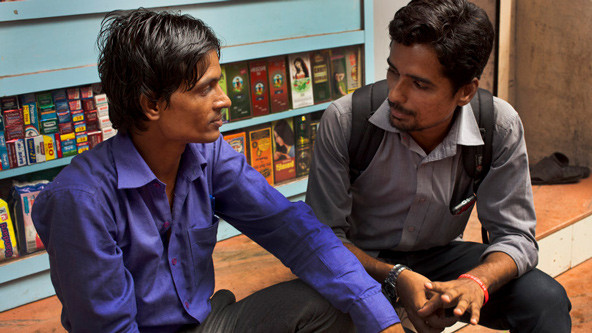 To reduce tuberculosis in India, NGOs and the government focused on changing the behaviors of private health care providers and patients. Here, an NGO staffer counsels a patient. (Photo courtesy of the Bill & Melinda Gates Foundation)
To reduce tuberculosis in India, NGOs and the government focused on changing the behaviors of private health care providers and patients. Here, an NGO staffer counsels a patient. (Photo courtesy of the Bill & Melinda Gates Foundation)
It’s a common conundrum: A nonprofit rolls out what it believes will be an impactful program, only to run into cultural traditions and taboos that result in constituents resisting an initiative that might dramatically improve their lives. In many cases, the solution is a matter of sequencing, where opening constituents’ minds to a program’s promise precedes efforts to execute the program itself. Behavior change campaigns that challenge stigma and discrimination have long been a core part of the strategy for reversing the global HIV epidemic. More broadly, books such as Presence have argued that most of us are stuck in deeply grooved patterns of seeing and acting—behaviors that blind us to fresh possibilities for transformative change.
In a 2018 report, “Bold Philanthropy in India,” The Bridgespan Group observed that the barriers to behavior change are arguably more pronounced in rural India, where “caste, patriarchy, and profoundly ingrained traditions can render communities resistant to social impact efforts, regardless of their level of need.” And yet, experience tells us that when we address the underlying sociological barriers that constrain constituents, we stand a better chance of achieving long-term impact.

How, then, can philanthropists and nonprofits encourage beneficial behavior change, without taking the paternalistic approach of imposing the change on constituents? One approach is to engage constituents directly, by enlisting local, trusted peers to investigate cultural norms and elicit change from within the community. Another approach, as illustrated by an initiative to battle tuberculosis in three Indian cities, is to impact constituents indirectly, by incentivizing critical collaborators to change their behaviors.
Focusing on Constituents: Internet Saathi
As described in an earlier SSIR article, when Tata Trusts and Google combined forces in 2015 to launch a program called Internet Saathi, which aims to increase digital literacy among India’s rural women, the initiative’s leaders knew they faced a formidable challenge. Back then, women comprised just 10 percent of Internet users in rural India.
However, when Internet Saathi set up group training sessions for village women in local community centers, a seemingly unbreakable cultural barrier raised the stakes: Because women were not permitted to travel alone, unaccompanied by a male family member, turnout for the training sessions was low. The organization needed a different strategy. After some consideration, it decided to hire a male trainer to ride a bicycle cart to rural villages and teach women where they were. But this tactic also failed to attract sufficient women, who were uncomfortable engaging with a man.
Following these two setbacks, Internet Saathi brainstormed once again, and this time innovated a change-from-within strategy. Instead of viewing rural women as passive beneficiaries, it would recruit and train local women on how to use smartphones. These “Saathis” (Hindi for “friend”) would go into neighboring villages and teach other women about the practical benefits of the Internet and how to deploy it in their daily lives.
Although the logic behind this peer-to-peer approach seemed sound, the effort was not an immediate success. The Saathis initially had trouble getting women to invest their time and attention, as many remained convinced that the Internet lacked relevancy in their day-to-day lives, but they eventually found ways to connect with likely adopters—often young people—in each community. This set off a ripple effect, where the early adopters, having grasped the Internet’s benefits, began to convert their neighbors. As the ripples of change crested from one household to the next, people began to look past the Internet’s downsides. Attitudes began to soften. Turnout to the trainings increased.
Partly because the push for digital literacy came from trusted female peers, the initiative scaled rapidly, spreading from village to village. As of April 2019, more than 65,000 Saathis had helped more than 24 million women in 18 states vault the digital gender divide.
To be sure, behaviors and beliefs that pre-date Internet Saathi still persist. Many rural women still can’t travel without a male family member. And yet, many Saathis are starting small businesses, and they are increasingly viewed as knowledge providers and community helpers. “It’s still not ideal,” says Neha Barjatya, chief of Internet Saathi. “But there has been a shift. People are more open to seeing women in a different light.”
Focusing on Collaborators: Tuberculosis-Control Initiative
Sometimes, a wider set of collaborators must change behaviors to achieve better social outcomes for constituents. Such was the case when the government of India—along with local governments, the Bill & Melinda Gates Foundation, and other partners—piloted an effort to help control tuberculosis (TB), the sixth-leading cause of death in India. To limit the spread of TB, the initiative’s leaders understood they would have to focus on potential collaborators—private health care providers—who serve as the first point of contact for 50-70 percent of patients with TB symptoms.
In India, private, licensed doctors are responsible for notifying the public health care system when new TB cases arise. However, many fail to do so. In 2016, some 1.1 million of the country’s TB cases went unreported, accounting for roughly one-third of all “missing” cases worldwide. When patients can’t complete their full treatment regimens, they run the risk of becoming resistant to first-line TB medications, and sadly, India has the world’s highest concentration of multidrug-resistant TB.
To eliminate TB, India would have to encourage the private health care sector to coordinate with the government’s TB control program, so patients could receive standardized care. That logic led the government and its partners to pilot an initiative for enlisting the private sector in mainstream efforts to diagnose and treat TB. The pilots rolled out in three major cities: Mumbai, Patna, and Mehsana. As a first step, the initiative sought to identify behaviors of private providers that might prevent TB patients from receiving high-quality care.
It began by launching a sweeping surveillance of TB care in Patna and Mumbai, using “standardized patients” (SPs). As recounted in a 2018 research paper, 24 adults recruited from local communities were trained to act as SPs, where they convincingly portrayed four different stages of TB symptoms. The goal was not to identify “bad” providers but to more-deeply understand the challenges that private providers confront when they encounter TB.
Over a nine-month period, the SPs conducted more than 2,650 incognito visits to more than 1,200 private health care facilities in the two cities. Investigators then assessed the type and quality of care the SPs received, and identified behaviors that contributed to sub-optimal treatment. According to two of the study’s co-authors, Jishnu Das and Madhukar Pai, three behaviors stood out:
- The study confirmed that the majority of private providers did not comply with the government’s TB treatment guidelines.
- There was great variation across the entire spectrum of private providers. As Das and Pai pointed out, some diagnosed and treated every patient correctly, while others misdiagnosed every case.
- Private providers over-medicate, but they don’t abuse anti-TB medications. Rather, they frequently over-prescribe “classes of drugs known as fluoroquinolones and steroids, both of which can mask the symptoms of TB and make diagnoses harder,” according to Das and Pai.
Having attained a clear-eyed view of providers’ behaviors and practices, the TB care initiative designed a change-from-within strategy to build private-public partnerships to fight TB. To incentivize private providers to work with the public health care system, the TB control initiative introduced an e-voucher system that reimbursed providers for the cost of chest X-rays and GeneXperts tests, as well as anti-TB medications. This enabled providers to reap the reputational benefits of providing their patients with free diagnostics and drugs.
At the same time, investigators concluded they could make significant progress by connecting TB patients with high-performing, “champion” providers and supporting them with supplemental training. Additionally, the initiative opted for “targeted messaging,” cautioning providers solely about the deleterious impacts that fluoroquinolones and steroids have on patients’ health.
These doable, behavior-change strategies—incentivizing providers with e-vouchers, identifying and training high-quality private providers, and narrowcasting messages about the consequences of over-prescribing certain medications—helped persuade more private-sector providers across the three cities to adhere to nationally mandated standards of TB care and to notify new TB cases to the government. As a result, more than 70 percent of the patients who participated in the initiative completed their treatment regimens.
The TB control initiative did not achieve these results by revamping the role of private health care providers. Rather, its leaders worked practical strategies into the existing system to motivate private providers to collaborate with their public counterparts and ultimately improve patients’ care.
Three Takeaways
When we look at the efforts of both Internet Saathi and the TB control initiative to shift behaviors and thereby seize promising opportunities to improve people’s lives, three lessons resonate. First, although an initiative might aim for revolutionary change—such as to close the digital gender divide—progress almost always depends on painstaking, evolutionary efforts to change behaviors from within. Internet Saathi endured two significant setbacks before it innovated its peer-to-peer teaching model. Even then, the Saathis had to cultivate early adopters before the model began to dramatically increase turnout at the village level.
Second, deep observation and learning is a prelude to deep-seated behavioral change. The leaders behind the TB care effort understood that before they could build an effective program, they had to understand providers’ contexts and experiences.
Finally, behavior change initiatives may make more progress when they evoke change, rather than impose it. Although Internet Saathi and the TB care effort targeted very different issues and populations, they both elicited behavior change by working within the community, culture, and prevailing system.
Support SSIR’s coverage of cross-sector solutions to global challenges.
Help us further the reach of innovative ideas. Donate today.
Read more stories by Niloufer Memon & Pritha Venkatachalam.

